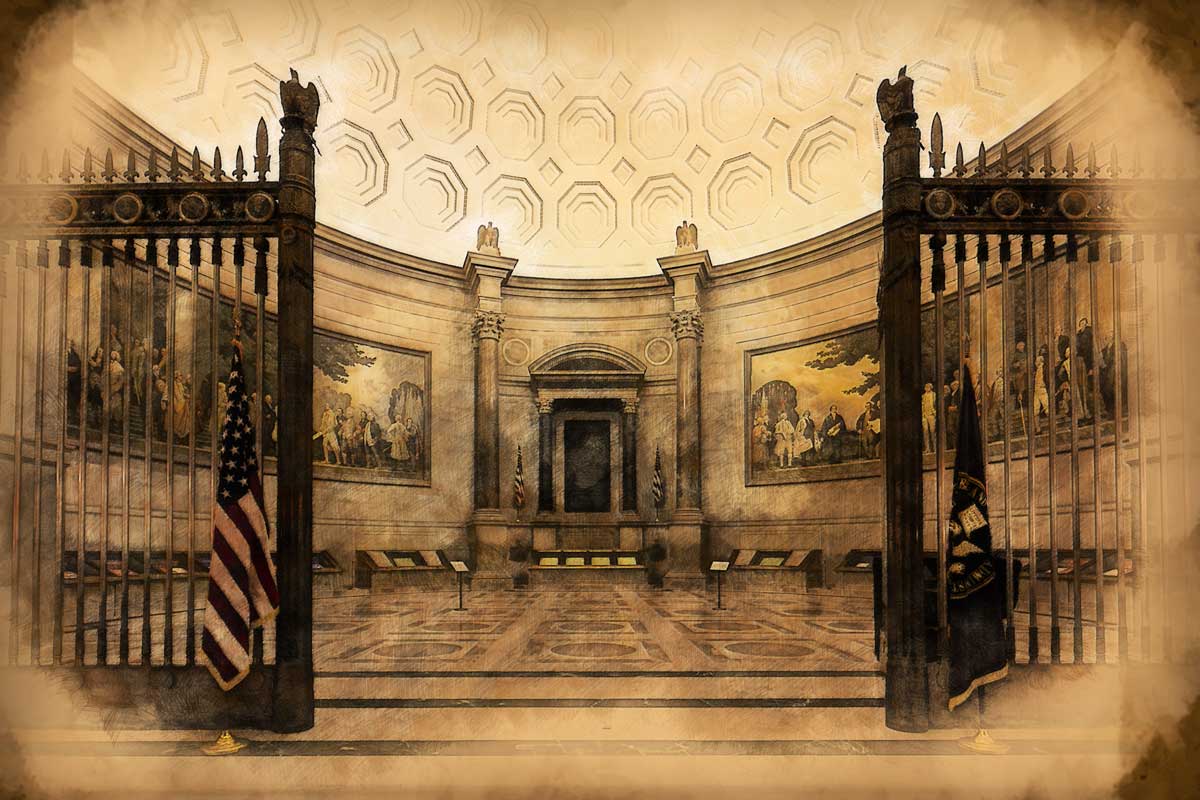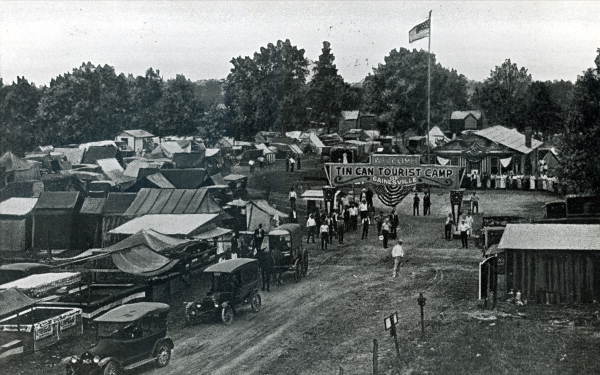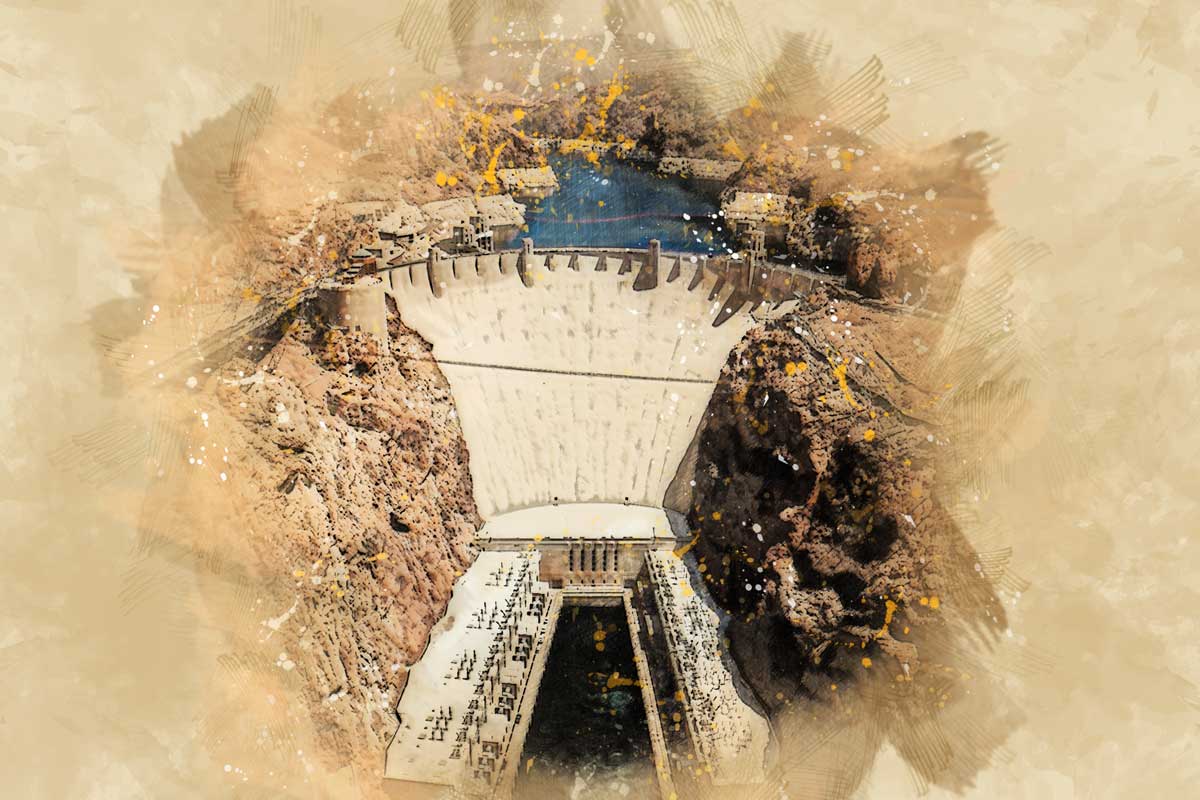Listen below, or on any podcast app:
By Jason Epperson
There’s one room on this earth that I have walked into that left me more humbled than any other. More proud and inspired. More happy and afraid and joyful. In one, oval-shaped room, the full weight of our nation and the American experience takes hold of you and doesn’t let go. No. Not that oval room, the hallowed Rotunda at the National Archives in Washington, D.C.
History of Charters of Freedom:
Designed by architect John Russell Pope as a shrine to American democracy, the Rotunda for the Charters of Freedom is the permanent home of the original Declaration of Independence, Constitution of the United States, and Bill of Rights.
Located on the upper level of the National Archives museum, the priceless documents stand at the center of a semicircle of display cases showing other vital records of the growth of the United States. The Declaration, the Constitution, and the Bill of Rights stand slightly elevated, under armed guard, in their bronze and marble shrine. The Bill of Rights and two of the five leaves of the Constitution are displayed flat. Above them, the Declaration of Independence is held impressively in an upright case constructed of ballistically tested glass and plastic laminate. Ultraviolet-light filters in the laminate give the inner layer a slightly greenish hue.
We hold these truths to be self-evident, that all men are created equal, that they are endowed by their Creator with certain unalienable Rights, that among these are Life, Liberty and the pursuit of Happiness.
The Declaration of Independence states the principles on which our Government, and our identity as Americans, are based. Unlike the other founding documents in the Rotunda, the Declaration of Independence is not legally binding, but it is powerful. Abraham Lincoln called it “a rebuke and a stumbling-block to tyranny and oppression.”
On July 19, 1776, once all 13 colonies had signified their approval of the Declaration of Independence, Congress ordered that it be “fairly engrossed on parchment.” Engrossed meaning “written fine, large, and clear.” Timothy Matlack, an assistant to the Secretary of the Congress, was most likely the penman.
On August 2, the journal of the Continental Congress records that “The declaration of independence being engrossed and compared at the table was signed.” John Hancock, President of the Congress, signed first. The delegates then signed by state from north to south. Some signed after August 2. A few refused. George Washington was away with his troops. Ultimately, 56 delegates signed the Declaration.
Next, in the center, is the Constitution’s four large pages.
The Constitution acted like a colossal merger, uniting a group of states with different interests, laws, and cultures. Under America’s first national government, the Articles of Confederation, the states acted together only for specific purposes. The Constitution united its citizens as members of a whole, vesting the power of the union in the people. Without it, the American Experiment might have ended as quickly as it had begun.
The state delegates approved the draft of the Constitution on September 15, 1787. The signing was set for the very next Monday. Jacob Shallus, the assistant clerk for the Pennsylvania General Assembly, agreed to engross the document. Over the course of about 40 hours, he created an accurate transcription of the draft. He was paid $30 for his efforts. On September 17, the document was ready for signing.
Thirty-nine of the 42 men present signed the Constitution. George Washington was first, followed by each state delegation descending from north to south. George Mason, Elbridge Gerry, and Edmund Randolph refused to sign because the Constitution lacked a bill of rights. Thomas Jefferson and John Adams did not sign because they were on diplomatic missions in Europe during the convention.
Finally, you get to visit what, to me, is the most sacred of American documents. The bill of Rights. The preamble reads:
The Conventions of a number of the States, having at the time of their adopting the Constitution, expressed a desire, in order to prevent misconstruction or abuse of its powers, that further declaratory and restrictive clauses should be added: And as extending the ground of public confidence in the Government, will best ensure the beneficent ends of its institution.
The Constitution might never have been ratified if the framers hadn’t promised to add a Bill of Rights. The first ten amendments to the Constitution gave citizens more confidence in the new Government and contain many of today’s Americans’ most valued freedoms.
The document on permanent display in the Rotunda is the enrolled original Joint Resolution passed by Congress on September 25, 1789, proposing 12-not 10-amendments to the Constitution.
William Lambert and Benjamin Bankson, engrossing clerks for the House and Senate, made 14 handwritten copies of the proposed amendments, which were signed by Speaker of the House Frederick Muhlenberg, Vice President John Adams, Clerk of the House of Representatives John Beckley, and Secretary of State Samuel A. Otis. President George Washington sent a letter enclosing one to each of the 11 existing states and to Rhode Island and North Carolina, which had not yet adopted the Constitution.
Transferring the Documents:
In 1933, while the Depression gripped the nation, President Hoover laid the cornerstone for the National Archives Building in D.C. He announced that the documents would eventually be kept in the impressive structure that was to occupy the site. It was for their keeping and display that the exhibition hall in the National Archives had been designed. Two large murals were painted for its walls. In one, Thomas Jefferson is depicted presenting the Declaration to John Hancock, President of the Continental Congress while members of that Revolutionary body look on. In the second, James Madison is portrayed submitting the Constitution to George Washington.
The final transfer of the documents did not, however, take place until almost 20 years later. In October 1934 President Franklin D. Roosevelt appointed the first Archivist of the United States, Robert Connor. The President told Connor that “valuable historic documents,” such as the Declaration of Independence and the U.S. Constitution, would reside in the National Archives Building. The Library of Congress, especially Librarian Herbert Putnam, objected. In a meeting with the President 2 months after his appointment, Connor explained to Roosevelt how the documents came to be in the Library and that Putnam felt another Act of Congress was necessary in order for them to be transferred to the Archives. Connor eventually told the President that it would be better to leave the matter alone until Putnam retired.
When he eventually did, Archibald MacLeish was nominated to the post. MacLeish agreed with Roosevelt and Connor that the two important documents belonged in the National Archives. During World War II much of the Declaration was stored at Fort Knox, MacLeish was unable to enact the transfer. By 1944, when the Declaration and Constitution returned to Washington, MacLeish had been appointed Assistant Secretary of State.
Connor had retired by now, and Solon J. Buck, the new Archivist of the United States, felt that the documents were in good hands at the Library of Congress. His successor, Wayne Grover, disagreed. Finally, Luther Evans, the Librarian of Congress appointed by President Truman in June 1945, agreed that the documents should be transferred to the Archives.
At 11 a.m., December 13, 1952, Brigadier General Stoyte O. Ross, commanding general of the Air Force Headquarters Command, formally received the documents at the Library of Congress. Twelve members of the Armed Forces Special Police carried the six pieces of parchment in their helium-filled glass cases, enclosed in wooden crates, down the Library steps through a line of 88 servicewomen. An armored Marine Corps personnel carrier awaited the documents. Once they had been placed on mattresses inside the vehicle, they were accompanied by a color guard, ceremonial troops, the Army Band, the Air Force Drum and Bugle Corps, two light tanks, four servicemen carrying submachine guns, and a motorcycle escort in a parade down Pennsylvania and Constitution Avenues to the Archives Building. Both sides of the parade route were lined by Army, Navy, Coast Guard, Marine, and Air Force personnel. At 11:35 a.m. General Ross and the 12 special policemen arrived at the National Archives Building, carried the crates up the steps, and formally delivered them into the custody of Archivist of the United States Wayne Grover. Already at the National Archives was the Bill of Rights, protectively sealed according to the techniques used a year earlier for the Declaration and Constitution.
The formal enshrining ceremony on December 15, 1952, was equally impressive. Chief Justice of the United States Fred M. Vinson presided over the ceremony, which was attended by officials of more than 100 national civic, patriotic, religious, veterans, educational, business, and labor groups. President Harry S. Truman, the featured speaker, said:
“The Declaration of Independence, the Constitution, and the Bill of Rights are now assembled in one place for display and safekeeping. . . . We are engaged here today in a symbolic act. We are enshrining these documents for future ages. . . . This magnificent hall has been constructed to exhibit them, and the vault beneath that we have built to protect them is as safe from destruction as anything that the wit of modern man can devise. All this is an honorable effort, based upon reverence for the great past, and our generation can take just pride in it.”
In 1987 the National Archives and Records Administration installed a $3 million camera and computerized system to monitor the condition of the three documents. The Charters Monitoring System was designed by the Jet Propulsion Laboratory to assess the state of preservation of the Constitution, the Declaration of Independence, and the Bill of Rights. It can detect any changes in readability due to ink flaking, off-setting of ink to glass, changes in document dimensions, and ink fading. The system is capable of recording in very fine detail 1-inch square areas of documents and later retaking the pictures in exactly the same places and under the same conditions of lighting. Periodic measurements are compared to the baseline image to determine if changes or deterioration invisible to the human eye have taken place.
At night, the documents are stored in an underground vault. In fact, if you’ve seen the movie “National Treasure, it got a lot of stuff right:
Eventually, it became clear that the documents were deteriorating even while hermetically sealed. Especially the Declaration of independence, which had, for much of its life, toured the world.
With more, here’s the last person to actually touch the Declaration of Independence, former supervisory conservator Mary Lynn Ritzenthaler:
Know Before You Go:
Visiting the National Archives is a D.C. must-do. And there’s so much more than these three documents in the museum. But you have to be prepared.
Reservations are not required for individuals or groups wishing to enter the National Archives Museum through the General Public Entrance, but reservations are strongly suggested between March and Labor Day to avoid potentially long lines outside. It can take up to 1 hour or more to enter.
Visitors are required to go through a security screening. Leave backpacks, large bags, and metal jewelry behind in order to expedite the security check. Backpacks, luggage, and other personal items are permitted in the museum but must remain with the visitors at all times. There are no lockers or coat check available.
There is no parking available at the museum. There is limited metered parking along Constitution Avenue, or visitors may take advantage of a number of public parking garages within a few blocks of the building. Use of the Metro system is highly recommended.
Jason Epperson is the co-host of the See America Podcast and Co-Founder of the RV Miles Network, a network of resources for the U.S. based traveler. He, along with his partner Abigail Trabue, travel the country full-time with their three boys discovering great destinations and exploring our National Parks.
To learn more about the RV Miles Network, including the RV Miles and America’s National Parks Podcasts, visit RVMiles.com.
Want to chat about great travel destinations all across the US? Join the See America Facebook Group and don’t forget to follow See America on Instagram, Facebook, and YouTube.
You can hear this story and more on the See America Podcast. Available on Apple Podcasts or wherever you listen to podcasts.

See America is sponsored by Roadtrippers. America’s #1 trip planning app. Enjoy 20% off your first year of Roadtrippers PLUS with the code RVMILES917X.








